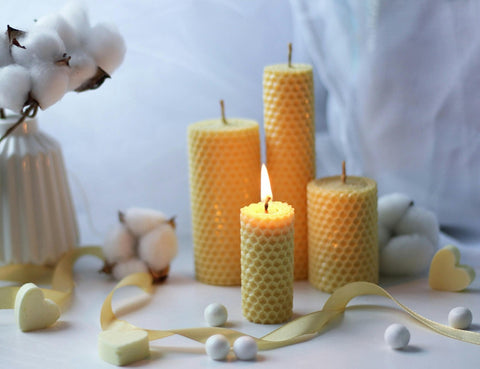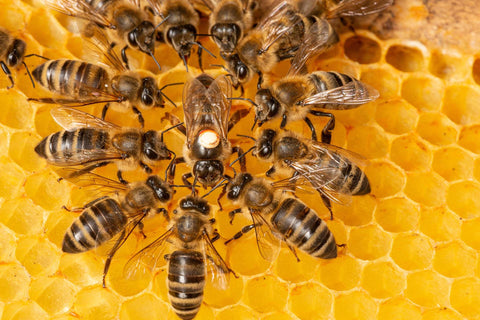What is Beeswax?
Beeswax is a natural wax made by young worker bees inside the hive. Bees use it to build the hexagonal cells of the honeycomb, which they use to store honey, raise young bees, and make “bee bread” from pollen.
Chemical Makeup
Beeswax is a complex substance made of over 280 compounds. Its main components include:
-
Monoesters (45–55%)
-
Hydrocarbons (15–18%)
-
Free fatty acids (10–15%)
-
Diesters & complex esters (8–12%)
-
Hydroxy monoesters (4–6%)
-
Free fatty alcohols (1–2%)
The exact composition varies depending on the type of bees, their location, and environment.
Beeswax has a low melting point (about 60–65°C), is not water-soluble, and works well in formulations—either thickening or softening them—making it a key ingredient in cosmetics.
How is Beeswax Made?
Young bees consume lots of honey, and their bodies convert it into wax, which is secreted as small flakes from glands on their abdomen. Other bees collect these flakes, chew them to soften the wax, and use it to build honeycomb cells.
Characteristics of Beeswax
Fresh beeswax is soft, white, and moldable. Over time, it darkens due to contact with propolis, pollen, and honey—eventually becoming golden, amber, or even brown, especially in brood cells.
Beekeepers melt and filter raw beeswax to remove impurities and lighten its color. Some commercial producers bleach beeswax to return it to a pale white.
The scent and color of beeswax vary depending on the hive’s environment, much like the flavor of honey.
Properties of Beeswax
Beeswax is:
-
Malleable: Easily shaped—called “the world’s first plastic.”
-
Chemically soluble: Can blend with oils and other substances.
-
Water-insoluble: Great for sealing and waterproofing.
-
Edible: Not digestible, but offers roughage and some health benefits.
-
Flammable: Burns cleanly, making it ideal for candles.
Benefits of Beeswax
Beeswax offers numerous natural advantages:
-
Moisturizes & Protects Skin: Locks in moisture, soothes irritation, and helps with conditions like eczema and rosacea.
-
Shields from Environmental Damage: Forms a protective barrier on the skin.
-
Supports Hair Health: Moisturizes, reduces breakage, and may promote growth.
Beeswax in History
Beeswax has been used for over 6,000 years. Ancient people used it to:
-
Fill dental cavities (earliest known use)
-
Make nail polish, medicine, and cosmetics (China & Egypt)
-
Embalm mummies and waterproof pottery
-
Seal letters and documents
-
Cast metal statues and jewelry using the lost wax method
-
Make candles that burned cleanly and brightly (especially in churches)
Modern Uses of Beeswax
Today, beeswax is a key ingredient in many household, cosmetic, and medical products.
Here are just a few ways you can use beeswax:
-
Make lip balm or natural lipstick
-
Polish wood furniture
-
Seal cutting boards or spoons
-
Condition leather or shoes
-
Style hair or beard
-
Treat minor wounds or eczema
-
Mold it into ornaments or decorations
-
Waterproof fabrics and shoes
-
Make reusable wax wraps for food
-
Create smokeless, dripless candles
More creative uses include:
-
Making crayons, modeling clay, and solid perfume
-
Preserving cheese and cast iron pans
-
Treating diaper rash and bug bites
-
Waxing thread, screws, or snowboards
-
Making natural fire starters and candy
How to Melt Beeswax Safely
Because beeswax sticks to surfaces and is hard to clean, melt it in a disposable metal can. Here's how:
You’ll Need:
-
A deep pot
-
A clean metal can (like from soup or tomatoes)
-
Water
-
Beeswax (shaved or in chunks)
-
Metal spoon
-
Heat source
Steps:
-
Clean a large metal can.
-
Place it in a pot filled halfway with water.
-
Add beeswax to the can and heat the water to a low boil.
-
Stir until the wax is fully melted.
-
Optional: Add pigment if you want to color the wax.
-
Carefully pour into molds or containers while still hot.




